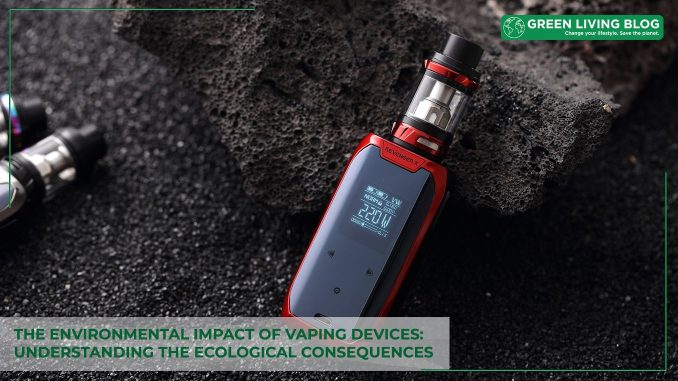
Electronic vaping devices have gained popularity as an alternative to traditional cigarettes, with many people considering them a more environmentally friendly and healthier choice.
However, it’s essential to assess the overall ecological impact of vaping devices, including their manufacturing, use, and disposal, and how they could potentially be reduced.
In this article, we will explore the potential environmental consequences associated with vaping devices and highlight areas where improvements can be made to minimize their ecological and carbon footprint.
What contributes to the Environmental Impact of Vapes?

Below we list the contributing factors of vape usage for the environment.
Manufacturing and Resources
Vaping devices, such as e-cigarettes and vape pens, require resources for their production. The manufacturing process involves the extraction and processing of materials like metals, plastics, and batteries.
These processes contribute to energy consumption, carbon emissions, and the depletion of natural resources. The extraction of metals, such as lithium, used in rechargeable batteries, has its own environmental challenges, including habitat destruction and water pollution.
Energy Consumption
Vaping devices require energy to function. Charging the batteries, heating the coils, and powering the electronic components all contribute to energy consumption. This energy is often derived from fossil fuels, leading to greenhouse gas emissions and exacerbating climate change.
Additionally, the charging infrastructure and electricity needed for vaping devices contribute to the overall demand on the electrical grid.
Waste Generation
Disposable vaping devices and related components pose a significant environmental challenge. E-cigarettes and vape pens are typically made of a combination of metal, plastic, and electronic components.
Improper disposal can lead to these materials ending up in landfills or, worse, being incinerated, releasing toxic substances into the atmosphere. Moreover, the disposal of rechargeable batteries, which often power vaping devices, requires proper handling due to their potential to leach harmful chemicals into the soil and water.
Chemical Exposure
The e-liquids used in vaping devices contain various chemicals, including propylene glycol, glycerin, and flavorings. Improper disposal of e-liquid containers or spills can lead to chemical contamination of water bodies, potentially harming aquatic ecosystems.
Furthermore, if vaping devices are not properly cleaned and maintained, the chemicals and residues can pose risks to human health and the environment.
Mitigating the Environmental Impact of Vapes

Here are some suggestions to reduce the environmental impact of vaping devices.
Responsible Manufacturing
Vaping device manufacturers should prioritize environmentally sustainable practices throughout the production process. This includes using recycled materials, reducing energy consumption during manufacturing, and implementing efficient waste management strategies.
Sustainable Power Sources
Encouraging the use of renewable energy sources, such as solar or wind power, for charging vaping devices can significantly reduce the carbon footprint associated with their use. Additionally, optimizing battery efficiency and promoting energy-saving features in devices can further reduce energy consumption.
Recycling and Disposal Programs
Establishing convenient and accessible recycling programs for vaping devices and their components is crucial. This can include collection centers or mail-in programs that allow users to dispose of their devices responsibly. Proper recycling ensures that valuable materials can be recovered and reused, reducing the demand for new resources.
User Education
Promoting awareness among vapers about the ecological impact of vaping devices is essential. Encouraging responsible use, proper maintenance, and safe disposal practices can significantly minimize environmental harm.
Providing clear instructions on how to clean and recycle devices, as well as educating users about the potential consequences of improper disposal, will foster a more environmentally conscious vaping community.
Closing Thoughts
While vaping devices may be seen as a potentially greener alternative to traditional smoking, it is essential to recognize their ecological impact. By understanding and addressing the environmental challenges associated with vaping devices, manufacturers, users, and regulatory bodies can work together to minimize the ecological footprint.
By embracing sustainable practices throughout the lifecycle of vaping devices, we can mitigate their impact on the environment and promote a more environmentally responsible vaping culture.
![]()
Author Profile

- Eco Warrior by day, Eco Blogger by night trying to get the eco balance right.
Latest entries
 Green GuidesNovember 3, 2025The Beginner’s Guide to Making Your Own Nontoxic Candles at Home
Green GuidesNovember 3, 2025The Beginner’s Guide to Making Your Own Nontoxic Candles at Home Green Home GuidesOctober 14, 2025What are Eco-Friendly Tissue Options for Modern UK Homes?
Green Home GuidesOctober 14, 2025What are Eco-Friendly Tissue Options for Modern UK Homes? Best practicesSeptember 17, 20253 Ways Young Families Can Commit to Sustainable Living
Best practicesSeptember 17, 20253 Ways Young Families Can Commit to Sustainable Living EnvironmentSeptember 9, 2025Eco-friendly Gardening on a Budget: 6 Sustainable Choices that make a Difference
EnvironmentSeptember 9, 2025Eco-friendly Gardening on a Budget: 6 Sustainable Choices that make a Difference





Leave a Reply
You must be logged in to post a comment.